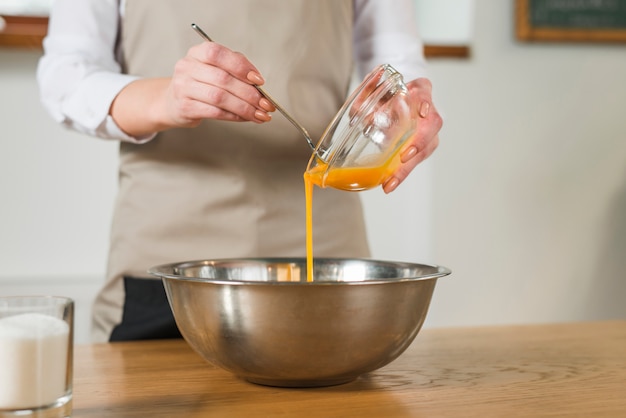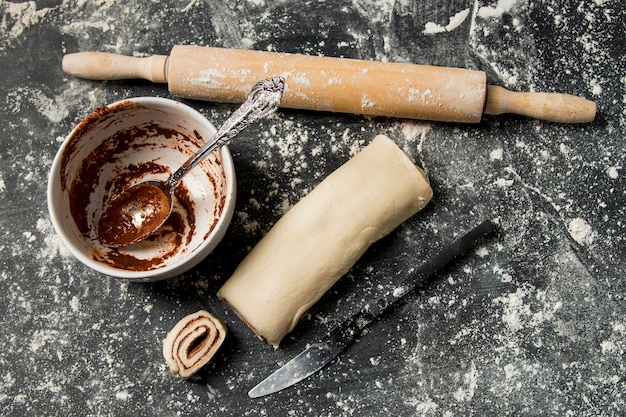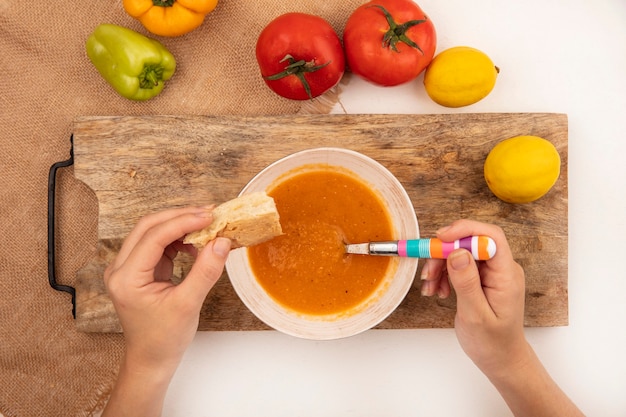Caramel. Just the word conjures up images of golden, gooey deliciousness, right? It's not just a sauce, it's a magical transformation – plain desserts suddenly become divine, simple drinks become decadent. But let's be honest, making caramel can be a little nerve-wracking. It's got a reputation for being tricky, for burning or crystallizing, for ending up more like a sticky mess than a smooth, luscious sauce.
But I'm here to tell you, making perfect caramel is totally achievable! In fact, it's downright empowering. Once you've mastered the basics, you'll feel like a culinary superhero, whipping up batches of this delightful sauce with confidence. So, grab your saucepan, whisk, and a good dose of patience, because we're about to embark on a caramel-making journey together.
(Part 1) Setting the Stage: Equipment and Ingredients

Before we even touch a sugar crystal, let's make sure we're set up for success. The right equipment and high-quality ingredients make all the difference.
Essential Equipment for Caramel Success
First things first, your trusty sidekick: a heavy-bottomed saucepan. Not just any saucepan will do, mind you. We need something sturdy, capable of handling those high temperatures without warping or burning. Look for one with a wide base, so the sugar has enough space to melt and caramelize evenly.
Next up, the trusty whisk. It's your ally in ensuring that caramel doesn't turn into a sticky, lumpy nightmare. I prefer a balloon whisk with a long handle, because it gives me a good grip and makes whisking easier, especially when the caramel starts to thicken.
Now, for measuring: a good digital kitchen scale is your best friend for weighing the sugar. Precision is key here. A standard measuring cup is fine for the water and cream, just make sure it has a spout for easy pouring.
The Ingredients that Make or Break Your Caramel
Let's talk ingredients. I'm a firm believer that good ingredients make for good results. You want caramel that sings with flavor, so starting with high-quality stuff is essential.
For sugar, I always go for granulated white sugar. It's readily available, affordable, and produces that classic caramel flavor we all know and love. Just make sure you're using a decent brand - you want sugar that's fine-grained and dissolves easily.
For water, I use filtered water, just to be extra sure it's free of impurities that could affect the clarity of the caramel. It's a small detail, but it makes a difference!
And finally, the cream. This is where things get luxurious. I always use heavy cream – it's got the highest fat content and yields the richest, most luscious caramel. For an extra touch of magic, I usually throw in a splash of vanilla extract. It's the final note that makes the caramel truly sing.
(Part 2) Mastering the Caramel Base: The Foundation of Flavor

Right, the moment we've all been waiting for: creating that beautiful, golden-amber caramel base. It's a dance of heat, time, and careful observation. But don't worry, I'll guide you through every step.
The Art of Melting Sugar: Slow and Steady Wins the Race
Gather your saucepan, whisk, and scale. Weigh out your sugar and pour it into the saucepan. Now, the key here is low heat. We're not in a rush. The goal is to melt the sugar slowly and evenly.
As the sugar melts, you'll notice it starts to turn a pale golden color. This is the moment of transformation! The sugar molecules are breaking down and restructuring, creating caramel. Keep a close eye on it, gently swirling the saucepan to ensure even melting.
Don't Touch It! The Importance of Patience
You might be tempted to stir constantly, but resist! Stirring too much can cause the sugar to crystallize, resulting in a lumpy, grainy mess. Let it do its thing, and you'll be rewarded with a smooth, silky caramel.
As the sugar melts further, the color deepens. It transitions from pale golden to a rich, beautiful amber hue. This is the crucial point where you need to be extra vigilant. The color can change quickly, so don't let it get too dark or it will develop a bitter taste.
The "doneness test": A Scientific Check for Perfect Caramel
You know that moment when you're baking, and you're wondering, "Is it done yet?" There's a simple way to test if your caramel is ready. It's called the "Doneness Test," and it's practically foolproof. Take a small amount of the melted sugar with a spoon and drop it into a bowl of ice water. If it solidifies immediately and is still pale in color, it's ready to go. But if it's sticky and doesn't harden up, it needs a little more cooking time.
Incorporating the Water: A Necessary Evil
Once your sugar is at the perfect caramel color, quickly add the water. It might seem strange, but the water is crucial. It helps prevent the caramel from burning and creates a smoother texture.
Now, here comes the exciting (and slightly intense) part. The caramel will sizzle and bubble like crazy when you add the water. Don't panic! Just keep swirling the saucepan gently to prevent scorching. The bubbles will subside, and the caramel will begin to smooth out. It'll look like a golden river flowing in your saucepan.
The Caramel Base is Ready: The Foundation is Set
After about 5 minutes, the water will have evaporated, leaving you with a smooth, shiny caramel base. It's ready for the next step: adding the cream, the final touch that will turn it into a delicious sauce.
(Part 3) The Cream: Adding the Finishing Touch

This is where caramel goes from a beautiful base to a truly irresistible sauce. We're about to introduce the cream, the secret ingredient that creates that smooth, velvety texture that melts in your mouth.
Working with the Cream: A Gentle Transformation
This is another crucial step. You need to add the cream gradually and carefully. I always heat the cream slightly before adding it. It's like a gentle nudge, encouraging the caramel to embrace the cream and blend into a beautiful harmony.
The Power of Patience: A Gentle Dance of Heat and Cream
As you pour the cream into the hot caramel, be prepared for a bit of a flurry. The caramel will bubble and sputter as it reacts with the cream, creating a beautiful golden froth. No need to worry, this is perfectly normal. Just keep whisking gently to incorporate the cream and bring the sauce back to a simmer.
The Sweet Symphony: A Perfect Blend of Caramel and Cream
As the cream is absorbed, the caramel transforms into a luscious sauce, becoming smooth and silky. The color will deepen slightly, and the aroma will be divine – a sweet symphony of caramel, butter, and vanilla.
Adjusting the Consistency: A Matter of Preference
Once the sauce has reached the desired consistency, you can decide whether you want it thick or thinner. For a thicker caramel, simply simmer it for a few more minutes.
If you prefer a thinner consistency, add a little more cream. But be careful not to overdo it, or it will dilute the caramel flavor. It's all about finding the perfect balance, like a delicate dance between sweetness and fluidity.
(Part 4) Bringing it All Together: Flavors and Variations
You've mastered the basic caramel sauce, now it's time to unleash your creativity! This is where the fun truly begins, exploring different flavors and variations, transforming your caramel into something truly unique.
Flavorful Twists: A Symphony of Taste
Caramel is a blank canvas, ready for your artistic touch. You can add all sorts of delicious ingredients to enhance its flavor, making it your own.
Here are a few of my personal favorite additions:
- Vanilla Extract: This is a classic for a reason. Vanilla adds a warm, comforting touch that complements the caramel beautifully, like a cozy hug in a bowl.
- Salt: A pinch of sea salt is a surprising and delightful addition. It brings out the sweetness of the caramel and creates a complex, balanced flavor, a perfect interplay of sweet and savory.
- Spices: A sprinkle of cinnamon or a dash of nutmeg adds a touch of warmth and complexity, transporting your taste buds to a different dimension of flavor.
- Chocolate: A tablespoon of cocoa powder or a few squares of dark chocolate add a rich, decadent twist, creating a luxurious experience for your senses.
- Coffee: A splash of espresso or a teaspoon of instant coffee creates a bold, robust flavor, adding a hint of caffeine kick to your caramel.
- Citrus: A squeeze of lemon juice or orange zest brings a bright, refreshing note, adding a touch of zesty sunshine to your caramel.
Caramel Variations: Beyond the Basics
Beyond just flavors, you can experiment with different textures and styles of caramel, creating a whole new world of caramel possibilities.
- Salted Caramel: A classic for a reason, salted caramel is a perfect balance of sweet and savory, a delightful dance on your taste buds.
- Chocolate Caramel: The ultimate indulgence, chocolate caramel combines the richness of chocolate with the sweetness of caramel, creating a decadent and irresistible treat.
- Caramel Sauce with Whipped Cream: A light and airy topping that elevates any dessert, adding a touch of fluffy cloudiness to your creation.
- Caramel Popcorn: A fun and addictive snack that's perfect for movie nights, bringing a sweet and salty crunch to your entertainment.
- Caramel Cake: A decadent dessert that's perfect for special occasions, adding a touch of elegance and sweetness to your celebration.
(Part 5) Storing and Serving Your Caramel Sauce: The Final Act
You've created a masterpiece, now it's time to store and serve it with pride.
Storing Your Caramel Sauce: Keeping it Fresh and Delicious
When it comes to storing caramel, it's all about keeping it fresh and delicious. I always store my caramel in an airtight container, preferably a glass jar. Let it cool completely before storing it. You can keep it at room temperature for up to a week, but for longer storage, refrigerate it for up to two weeks.
Warming Up Your Caramel: Reviving the Magic
When you're ready to serve your caramel, simply warm it up gently over low heat. You don't want to overheat it, as this could cause it to become grainy. A few minutes over low heat is all you need to revive its luscious, smooth texture.
Serving Suggestions: A World of Possibilities
Caramel is incredibly versatile. It's a delicious topping for cakes, ice cream, and fruit. You can drizzle it over pancakes, waffles, and crepes. It's also a wonderful addition to coffee, tea, and hot chocolate, adding a touch of sweet magic to your daily routine.
Creative culinary adventures: Exploring New Horizons
If you're feeling adventurous, try incorporating caramel into your savory dishes. It can add a touch of sweetness and complexity to sauces, marinades, and even glazes, creating unexpected and delightful flavor combinations.
(Part 6) Common Caramel Mishaps and Solutions: Navigating the Challenges
Let's be honest, sometimes things don't go according to plan in the kitchen. But don't worry, even the most seasoned chefs have encountered caramel mishaps. The key is to learn from your mistakes and try again!
Crystallization: The Enemy of Smooth Caramel
One of the most common problems is crystallization. This happens when sugar crystals form in the caramel, creating a grainy texture. It's usually caused by stirring too much or not melting the sugar completely.
To prevent crystallization, avoid stirring the sugar as it melts. Just gently swirl the saucepan to ensure even melting. If crystallization does occur, you can try dissolving the crystals by adding a tablespoon of water and heating the caramel over low heat.
Burning: The Bitter Truth
Another common issue is burning. This happens when the sugar gets too hot and starts to turn dark brown. It can give the caramel a bitter taste.
To prevent burning, use low heat and keep a close eye on the caramel as it melts. Don't let it get too dark. If it does burn, you can try to salvage the caramel by adding a little bit of cream and whisking vigorously. But be warned, the caramel will be slightly bitter.
Lumpy Caramel: The Curse of Uneven Heating
Lumpy caramel can be caused by uneven heating or not stirring properly. It's a little more forgiving to work with than burnt caramel, but it's still not ideal.
To prevent lumps, use a heavy-bottomed saucepan and stir gently as the sugar melts. If you find your caramel is lumpy, you can try to smooth it out by heating it over low heat and whisking vigorously. But sometimes, the lumps are just a fact of life.
(Part 7) Caramel FAQs: Answers to Your Burning Questions
Here are some of the most common questions about making caramel:
1. Can I use brown sugar instead of white sugar?
Yes, you can use brown sugar, but it will produce a darker, richer caramel with a slightly more molasses-like flavor. The caramel will also have a thicker consistency.
2. Can I substitute the cream with milk or water?
You can substitute the cream with milk or water, but it won’t have the same rich, smooth texture. Milk will create a slightly thinner caramel, while water will create a much thinner, more runny caramel.
3. How long can I store caramel sauce?
You can store caramel sauce at room temperature for up to a week or in the refrigerator for up to two weeks. If you want to store it for longer, you can freeze it for up to three months.
4. Can I make caramel in advance?
Yes, you can make caramel in advance. Just let it cool completely before storing it in an airtight container. You can store it at room temperature for up to a week or in the refrigerator for up to two weeks.
5. What if my caramel is too thick or too thin?
If your caramel is too thick, you can add a little more cream and heat it gently over low heat to thin it out. If your caramel is too thin, you can simmer it for a few more minutes to thicken it.
(Part 8) Final Thoughts: A Journey of Flavor and Discovery
There you have it! Your ultimate guide to making perfect caramel sauce. It's a process that takes a little time, a little patience, and a little bit of love, but it's worth every moment. You'll have the satisfaction of creating something delicious and beautiful, something that will impress your friends and family. And you'll discover that the joy of caramel making isn't just about the sauce itself, it's about the journey - the excitement of the melting sugar, the anticipation of the perfect color, and the pride you feel when you finally create that smooth, golden nectar. So, go forth and make some caramel. You won't regret it!
Everyone is watching

Corn on the Cob: The Ultimate Guide to Perfectly Cooked Ears
Healthy MealsAh, corn on the cob. Just the name evokes images of sunny days, barbecues, and that sweet, juicy flavour that ...

Perfect Pork Roast Oven Cooking Time: A Guide to Delicious Results
Healthy MealsThere's something truly satisfying about a perfectly roasted pork. The aroma alone is enough to make your mout...

Ham Cooking Time: How Long to Bake, Smoke, or Boil a Delicious Ham
Healthy MealsAh, ham. It's a classic, isn't it? A real crowd-pleaser, especially around holidays. And when done right, it'...

Scallops: The Ultimate Guide to Perfect Cooking
Healthy MealsAh, scallops. Those delicate, sweet, and utterly delicious morsels of the sea. They hold a special place in my...

Spaghetti Squash: The Ultimate Guide to Cooking and Serving
Healthy MealsRemember that time you saw spaghetti squash at the supermarket, looking all bumpy and strange, and thought, "W...
